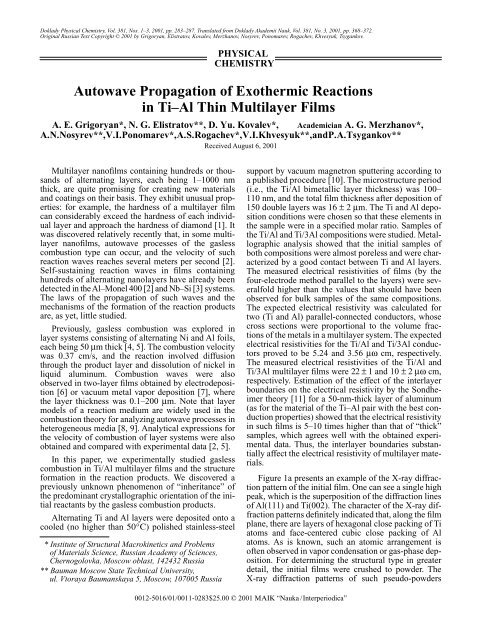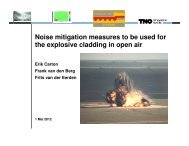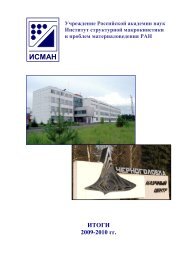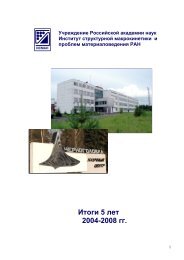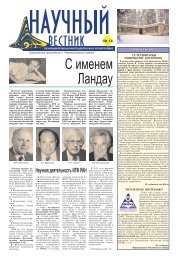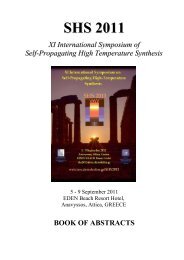Autowave Propagation of Exothermic Reactions in Ti–Al Thin ...
Autowave Propagation of Exothermic Reactions in Ti–Al Thin ...
Autowave Propagation of Exothermic Reactions in Ti–Al Thin ...
Create successful ePaper yourself
Turn your PDF publications into a flip-book with our unique Google optimized e-Paper software.
Doklady Physical Chemistry, Vol. 381, Nos. 1–3, 2001, pp. 283–287. Translated from Doklady Akademii Nauk, Vol. 381, No. 3, 2001, pp. 368–372.Orig<strong>in</strong>al Russian Text Copyright © 2001 by Grigoryan, Elistratov, Kovalev, Merzhanov, Nosyrev, Ponomarev, Rogachev, Khvesyuk, Tsygankov.PHYSICALCHEMISTRY<strong>Autowave</strong> <strong>Propagation</strong> <strong>of</strong> <strong>Exothermic</strong> <strong>Reactions</strong><strong>in</strong> <strong>Ti–Al</strong> Th<strong>in</strong> Multilayer FilmsA. E. Grigoryan*, N. G. Elistratov**, D. Yu. Kovalev*, Academician A. G. Merzhanov*,A. N. Nosyrev**, V. I. Ponomarev*, A. S. Rogachev*, V. I. Khvesyuk**, and P. A. Tsygankov**Received August 6, 2001Multilayer nan<strong>of</strong>ilms conta<strong>in</strong><strong>in</strong>g hundreds or thousands<strong>of</strong> alternat<strong>in</strong>g layers, each be<strong>in</strong>g 1–1000 nmthick, are quite promis<strong>in</strong>g for creat<strong>in</strong>g new materialsand coat<strong>in</strong>gs on their basis. They exhibit unusual properties:for example, the hardness <strong>of</strong> a multilayer filmcan considerably exceed the hardness <strong>of</strong> each <strong>in</strong>dividuallayer and approach the hardness <strong>of</strong> diamond [1]. Itwas discovered relatively recently that, <strong>in</strong> some multilayernan<strong>of</strong>ilms, autowave processes <strong>of</strong> the gaslesscombustion type can occur, and the velocity <strong>of</strong> suchreaction waves reaches several meters per second [2].Self-susta<strong>in</strong><strong>in</strong>g reaction waves <strong>in</strong> films conta<strong>in</strong><strong>in</strong>ghundreds <strong>of</strong> alternat<strong>in</strong>g nanolayers have already beendetected <strong>in</strong> the Al–Monel 400 [2] and Nb–Si [3] systems.The laws <strong>of</strong> the propagation <strong>of</strong> such waves and themechanisms <strong>of</strong> the formation <strong>of</strong> the reaction productsare, as yet, little studied.Previously, gasless combustion was explored <strong>in</strong>layer systems consist<strong>in</strong>g <strong>of</strong> alternat<strong>in</strong>g Ni and Al foils,each be<strong>in</strong>g 50 µm thick [4, 5]. The combustion velocitywas 0.37 cm/s, and the reaction <strong>in</strong>volved diffusionthrough the product layer and dissolution <strong>of</strong> nickel <strong>in</strong>liquid alum<strong>in</strong>um. Combustion waves were alsoobserved <strong>in</strong> two-layer films obta<strong>in</strong>ed by electrodeposition[6] or vacuum metal vapor deposition [7], wherethe layer thickness was 0.1–200 µm. Note that layermodels <strong>of</strong> a reaction medium are widely used <strong>in</strong> thecombustion theory for analyz<strong>in</strong>g autowave processes <strong>in</strong>heterogeneous media [8, 9]. Analytical expressions forthe velocity <strong>of</strong> combustion <strong>of</strong> layer systems were alsoobta<strong>in</strong>ed and compared with experimental data [2, 5].In this paper, we experimentally studied gaslesscombustion <strong>in</strong> Ti/Al multilayer films and the structureformation <strong>in</strong> the reaction products. We discovered apreviously unknown phenomenon <strong>of</strong> “<strong>in</strong>heritance” <strong>of</strong>the predom<strong>in</strong>ant crystallographic orientation <strong>of</strong> the <strong>in</strong>itialreactants by the gasless combustion products.Alternat<strong>in</strong>g Ti and Al layers were deposited onto acooled (no higher than 50°ë) polished sta<strong>in</strong>less-steel* Institute <strong>of</strong> Structural Macrok<strong>in</strong>etics and Problems<strong>of</strong> Materials Science, Russian Academy <strong>of</strong> Sciences,Chernogolovka, Moscow oblast, 142432 Russia** Bauman Moscow State Technical University,ul. Vtoraya Baumanskaya 5, Moscow, 107005 Russiasupport by vacuum magnetron sputter<strong>in</strong>g accord<strong>in</strong>g toa published procedure [10]. The microstructure period(i.e., the Ti/Al bimetallic layer thickness) was 100–110 nm, and the total film thickness after deposition <strong>of</strong>150 double layers was 16 ± 2 µm. The Ti and Al depositionconditions were chosen so that these elements <strong>in</strong>the sample were <strong>in</strong> a specified molar ratio. Samples <strong>of</strong>the Ti/Al and Ti/3Al compositions were studied. Metallographicanalysis showed that the <strong>in</strong>itial samples <strong>of</strong>both compositions were almost poreless and were characterizedby a good contact between Ti and Al layers.The measured electrical resistivities <strong>of</strong> films (by thefour-electrode method parallel to the layers) were severalfoldhigher than the values that should have beenobserved for bulk samples <strong>of</strong> the same compositions.The expected electrical resistivity was calculated fortwo (Ti and Al) parallel-connected conductors, whosecross sections were proportional to the volume fractions<strong>of</strong> the metals <strong>in</strong> a multilayer system. The expectedelectrical resistivities for the Ti/Al and Ti/3Al conductorsproved to be 5.24 and 3.56 µω cm, respectively.The measured electrical resistivities <strong>of</strong> the Ti/Al andTi/3Al multilayer films were 22 ± 1 and 10 ± 2 µω cm,respectively. Estimation <strong>of</strong> the effect <strong>of</strong> the <strong>in</strong>terlayerboundaries on the electrical resistivity by the Sondheimertheory [11] for a 50-nm-thick layer <strong>of</strong> alum<strong>in</strong>um(as for the material <strong>of</strong> the <strong>Ti–Al</strong> pair with the best conductionproperties) showed that the electrical resistivity<strong>in</strong> such films is 5–10 times higher than that <strong>of</strong> “thick”samples, which agrees well with the obta<strong>in</strong>ed experimentaldata. Thus, the <strong>in</strong>terlayer boundaries substantiallyaffect the electrical resistivity <strong>of</strong> multilayer materials.Figure 1a presents an example <strong>of</strong> the X-ray diffractionpattern <strong>of</strong> the <strong>in</strong>itial film. One can see a s<strong>in</strong>gle highpeak, which is the superposition <strong>of</strong> the diffraction l<strong>in</strong>es<strong>of</strong> Al(111) and Ti(002). The character <strong>of</strong> the X-ray diffractionpatterns def<strong>in</strong>itely <strong>in</strong>dicated that, along the filmplane, there are layers <strong>of</strong> hexagonal close pack<strong>in</strong>g <strong>of</strong> Tiatoms and face-centered cubic close pack<strong>in</strong>g <strong>of</strong> Alatoms. As is known, such an atomic arrangement is<strong>of</strong>ten observed <strong>in</strong> vapor condensation or gas-phase deposition.For determ<strong>in</strong><strong>in</strong>g the structural type <strong>in</strong> greaterdetail, the <strong>in</strong>itial films were crushed to powder. TheX-ray diffraction patterns <strong>of</strong> such pseudo-powders0012-5016/01/0011- 00283$25.00 © 2001 åÄIä “Nauka /Interperiodica”
284GRIGORYAN et al.(a)(b)K β(111)TiAl(103)Ti 3 AlK β(100)Ti 3 Al (111)TiAl(101)Ti 3 Al(002)TiAl(202)TiAl(102)Ti 3 Al(202)TiAl(113)TiAl(311)TiAl(103)Ti 3 AlK β(111)Al, (002)TiK β(100)Ti(200)Al(101)Ti (111)Al,(002)Ti(102)Ti(220)Al(110)Ti(103)Ti(c)(d)(112), (103)TiAlK 3 ,β(111) TiAl(004) TiAl 3(002) TiAl(200) TiAl 3(e)(204) TiAl 3(220) TiAl(116) TiAl 3(112), (103)TiAl 3 ,(111) TiAlK β(004),TiAl 3 ,(002)TiAl(200)TiAl(200)TiAl 3(f)(204)TiAl 3(202)TiAl(220)TiAl 3(116)TiAl 330 40 50 60 70 80 30 40 50 60 70 802θFig. 1. Typical X-ray diffraction patterns <strong>of</strong> (a) Ti/Al multilayer film, (b) Ti/Al multilayer film crushed to powder, (c) burned Ti/Almultilayer film, (d) burned Ti/Al multilayer film crushed to powder, (e) burned Ti/3Al multilayer film, and (f) burned Ti/3Al multilayerfilm crushed to powder.exhibited peaks <strong>of</strong> all Ti and Al atomic planes (Fig. 1b).Thus, the <strong>in</strong>itial film consisted <strong>of</strong> crystall<strong>in</strong>e layersreta<strong>in</strong><strong>in</strong>g the same short- and long-range orders as those<strong>in</strong> bulk crystals <strong>of</strong> titanium and alum<strong>in</strong>um. The diffractionl<strong>in</strong>es were somewhat broadened, which was likelydue to a high concentration <strong>of</strong> structural defects.For study<strong>in</strong>g the gasless combustion, the multilayerfilm was removed from the support and cut <strong>in</strong>to5 × 20-mm strips, which were fixed <strong>in</strong>to mica clampsand were placed <strong>in</strong>to a vacuum <strong>of</strong> 10 –3 Pa. The reactionwas <strong>in</strong>itiated at one <strong>of</strong> the strip ends by a short (≈0.5 s)heat pulse produced by a th<strong>in</strong> tungsten wire. Figure 2demonstrates a typical steady-state self-susta<strong>in</strong><strong>in</strong>gwave as recorded by high-speed (500 frames per second)micro video record<strong>in</strong>g. For achiev<strong>in</strong>g a steadystatecombustion <strong>of</strong> Ti/Al samples, they had to be <strong>in</strong>i-DOKLADY PHYSICAL CHEMISTRY Vol. 381 Nos. 1–3 2001
AUTOWAVE PROPAGATION OF EXOTHERMIC REACTIONS 2854 mmFig. 2. Combustion wave <strong>in</strong> Ti/3Al multilayer film.Glow <strong>in</strong>tensity, arb. units600500400433002001 21000 5 10 15Distance, mmFig. 3. Glow <strong>in</strong>tensity pr<strong>of</strong>iles for waves <strong>of</strong> combustion <strong>of</strong> (1) Ti/Al multilayer film at an <strong>in</strong>itial temperature <strong>of</strong> T 0 = 20°ë (the wavedies out near the ignition po<strong>in</strong>t), (2) Ti/Al multilayer film at T 0 = 100°ë, (3) Ti/Al multilayer film at T 0 = 200°ë, and (4) Ti/3Almultilayer film at T 0 = 20°ë.tially heated. This was performed by a molybdenumfoilribbon radiator positioned parallel to a sample at adistance <strong>of</strong> 2–3 cm. The temperature was controlledwith a thermocouple. Samples at an <strong>in</strong>itial temperature<strong>of</strong> 100°ë burned at a velocity <strong>of</strong> ~5 cm/s. Heat<strong>in</strong>g to200°ë <strong>in</strong>creased the combustion velocity to 20 cm/s.Heat<strong>in</strong>g to 350–400°ë caused a self-ignition: the reactionwas <strong>in</strong>itiated locally before application <strong>of</strong> an ignit<strong>in</strong>gheat pulse, and the gasless combustion front propagatedat a velocity <strong>of</strong> about 26 cm/s. An <strong>in</strong>crease <strong>in</strong> thepower and the duration <strong>of</strong> an ignit<strong>in</strong>g heat pulse appliedto unheated samples (at an <strong>in</strong>itial temperature <strong>of</strong> 20°ë)gave rise to a combustion wave, which propagated fromthe ignition po<strong>in</strong>t <strong>in</strong> a pulsed mode and died out, hav<strong>in</strong>gtraveled a distance <strong>of</strong> 1–1.5 cm. The existence <strong>of</strong> sucha wave was apparently possible only <strong>in</strong> a foil regionheated by the ignit<strong>in</strong>g wire. When the combustion frontarrived at unheated regions, it died out. Ti/3Al samplesreacted without preheat<strong>in</strong>g, and the reaction wavevelocity was 150 cm/s. Figure 3 presents the glow<strong>in</strong>tensity pr<strong>of</strong>iles for different combustion waves. Asone can see from Figs. 2 and 3, the width <strong>of</strong> the front(the heat<strong>in</strong>g and reaction zone) was 1–2 mm. In Ti/Alsamples, cool<strong>in</strong>g began immediately beh<strong>in</strong>d the front;and <strong>in</strong> Ti/3Al samples, there was quite a wide regionwhere the matter cont<strong>in</strong>ued to burn.All samples that burned <strong>in</strong> the steady-state modereta<strong>in</strong>ed their sizes and shape. In samples burned <strong>in</strong> theunsteady-state mode, folds formed. The X-ray diffractionpatterns <strong>of</strong> burned foils <strong>in</strong> Figs. 1c and 1e showedthat the sample texture (the orientation <strong>of</strong> atomic layers)persisted <strong>in</strong> Ti/Al samples and was partially disturbed<strong>in</strong> Ti/3Al samples.The X-ray diffraction patterns <strong>of</strong> crushed burnedsamples exhibit diffraction l<strong>in</strong>es <strong>of</strong> other crystallographicplanes (Figs. 1d and 1f). In both cases, theproduct is two-phase: <strong>in</strong> TiAl foils, the reaction yieldsTiAl and Ti 3 Al; and <strong>in</strong> Ti/3Al foils, the reaction productsare TiAl 3 and TiAl. The characteristics <strong>of</strong> the crystalstructure <strong>of</strong> the products are listed <strong>in</strong> the table. It is<strong>in</strong>terest<strong>in</strong>g that additional vacuum anneal<strong>in</strong>g <strong>of</strong> burnedDOKLADY PHYSICAL CHEMISTRY Vol. 381 Nos. 1–3 2001
286GRIGORYAN et al.Crystal lattice parameters <strong>of</strong> combustion productsPhaseStructural type,space groupUnit cell parameters, ÅacTi 3 Al hexagonal 5.758 4.625P6^3/mmc (5.770) (4.620)TiAl tetragonal 3.999 4.065P4/mmc (3.976) (4.049)TiAl 3 tetragonal 3.885 8.593I3/mmm (3.854) (8.584)Note: Parenthesized are ASTM standard values.foils for 1 h at 1000°ë caused no substantial changes <strong>in</strong>their composition.The most <strong>in</strong>trigu<strong>in</strong>g phenomenon, which, to ourknowledge, has not been described <strong>in</strong> the literature, isthe “<strong>in</strong>heritance” <strong>of</strong> the predom<strong>in</strong>ant crystallographicorientation <strong>of</strong> the <strong>in</strong>itial reactants by the gasless combustionproduct. This phenomenon is likely to be possible<strong>in</strong> systems where the atomic radii <strong>of</strong> the reactantsand, consequently, the <strong>in</strong>teratomic distances along aclose pack<strong>in</strong>g plane are similar, i.e., where there is goodcrystallographic match<strong>in</strong>g between the reactants. AsFig. 4 shows, crystallographic match<strong>in</strong>g takes place forthe <strong>Ti–Al</strong> system. The closely packed planes Ti(002),Al(111), TiAl(111), Ti 3 Al(002), and TiAl 3 (112) differonly <strong>in</strong> the relative fractions <strong>of</strong> Ti and Al atoms and <strong>in</strong>the order <strong>of</strong> their arrangement. Therefore, one canassume that the formation <strong>of</strong> the phases <strong>of</strong> the product<strong>in</strong> Ti/Al samples occurs by the solid-phase cross diffusion<strong>of</strong> atoms along a normal to a close pack<strong>in</strong>g plane(across the layers) without disturb<strong>in</strong>g the orientation <strong>of</strong>these atomic planes. Know<strong>in</strong>g the reaction zone width l(Fig. 3), the layer thickness d, and the combustionvelocity U from the experiment, one can approximatelyestimate the diffusion coefficient D. Assum<strong>in</strong>g that thereaction occurs through atomic diffusion and equat<strong>in</strong>gthe characteristic diffusion time τ D = d 2 /4D to the reactiontime τ R = l/U, we obta<strong>in</strong>D ≅ d 2 U/4l.The substitution <strong>of</strong> the experimental values d ≅ 60 nm,U = 30 cm/s, and l ≅ 1 mm gives D ≅ 3 × 10 –10 cm 2 /s,which corresponds to the solid-phase diffusion, particularlyat high concentration <strong>of</strong> structural defects. However,the front glow <strong>in</strong>tensity suggests that the combustiontemperature is def<strong>in</strong>itely higher than the melt<strong>in</strong>gpo<strong>in</strong>t <strong>of</strong> alum<strong>in</strong>um. For this fact to be consistent withthe preservation <strong>of</strong> the orientation <strong>of</strong> closely packedatomic planes, one has to assume that either the atomicorder<strong>in</strong>g is reta<strong>in</strong>ed <strong>in</strong> a th<strong>in</strong> melt layer or the productforms on the basis <strong>of</strong> the solid titanium structure. In thelatter case, the diffusion <strong>of</strong> alum<strong>in</strong>um <strong>in</strong>to titaniumand/or the growth <strong>of</strong> solid product layers at the <strong>in</strong>terlayerboundaries should leave the titanium dissolution<strong>in</strong> liquid alum<strong>in</strong>um beh<strong>in</strong>d. The comparatively weakeffect <strong>of</strong> the dissolution is also expla<strong>in</strong>ed by the lowsolubility <strong>of</strong> titanium <strong>in</strong> liquid alum<strong>in</strong>um: at 1000°C,the saturation concentration does not exceed 3–4 wt %.In Ti/3Al samples, the volume content <strong>of</strong> the meltis higher, which apparently enables the nucleation andgrowth <strong>of</strong> product gra<strong>in</strong>s, whose crystal structure isoriented differently than the <strong>in</strong>itial layers. The velocity<strong>of</strong> combustion <strong>of</strong> samples <strong>of</strong> this composition ishigh (1.5 m/s), and the reaction zone width reaches5 mm; therefore, the diffusion coefficient is estimatedat D ~ 3 × 10 –9 cm 2 /s. The diffusion coefficients <strong>of</strong> alum<strong>in</strong>umatoms through titanium up to a temperature <strong>of</strong> 920 Kare available <strong>in</strong> the literature [12]. Extrapolat<strong>in</strong>g thesedata to higher temperatures, one can approximatelyTi (002) Al (111)TiAl (111) TiAl 3 (112) Ti 3 Al (002)Fig. 4. Closely packed atomic planes <strong>in</strong> the phases <strong>of</strong> the titanium (black circles)–alum<strong>in</strong>um (gray circles) system.DOKLADY PHYSICAL CHEMISTRY Vol. 381 Nos. 1–3 2001
AUTOWAVE PROPAGATION OF EXOTHERMIC REACTIONS 287estimate the diffusion coefficients at the adiabatic combustiontemperature (1520 K). Estimates showed that, <strong>in</strong>the case <strong>of</strong> the formation <strong>of</strong> the TiAl 3 phase at the boundary,the diffusion coefficients <strong>of</strong> alum<strong>in</strong>um atomsthrough titanium at this temperature is 1.2 × 10 –18 cm 2 /s;and <strong>in</strong> the case <strong>of</strong> the formation <strong>of</strong> a solid solution, it is3 × 10 –15 cm 2 /s. The diffusion rate <strong>in</strong> our experimentsproved to be several orders <strong>of</strong> magnitude higher thanthe diffusion rate <strong>in</strong> bulk samples. This phenomenon islikely to be due to a large number <strong>of</strong> vacancies andother structural defects.Thus, <strong>in</strong> this paper, we experimentally studied somefeatures <strong>of</strong> the gasless combustion <strong>in</strong> multilayer filmsand discovered the phenomenon <strong>of</strong> “<strong>in</strong>heritance” <strong>in</strong> thecrystallographic orientation <strong>of</strong> the <strong>in</strong>itial nanolayers bythe combustion product.ACKNOWLEDGMENTSWe thank A. E. Sychev for his help <strong>in</strong> the organization<strong>of</strong> jo<strong>in</strong>t <strong>in</strong>vestigations. This work was supported bythe Russian Foundation for Basic Research (projectnos. 01–03–33017 and 00–15–97370) and the Scientificand Technical Program <strong>of</strong> the M<strong>in</strong>istry <strong>of</strong> Education<strong>of</strong> the Russian Federation (no. 001/06.01.16).REFERENCES1. Yashar, P.C. and Sproul, W.D., Vacuum, 1999, vol. 55,pp. 179–190.2. Barbee, T.W. and Weihs, T., US Patent 5538795, 1996.3. Reiss, M.E., Esber, C.M., Van Heerden, D., et al., Mater.Sci. Eng., 1999, vol. 261, pp. 217–222.4. Shcherbakov, V.A., Shte<strong>in</strong>berg, A.S., and Munir, Z.A.,Dokl. Akad. Nauk, 1999, vol. 364, no. 5, pp. 647–652[Dokl. Chem. (Engl. Transl.), vol. 364, nos. 4–6,pp. 34–38].5. Shcherbakov, V.A., Shte<strong>in</strong>berg, A.S., and Munir, Z.A.,Combust. Sci. Tech. 2001. (http://xxx.lanl.gov/abs/physics/0107026).6. Vadchenko, S.G., Bulaev, A.M., Gal’chenko, Yu.A., andMerzhanov, A.G., Fiz. Gorenia Vzryva, 1987, vol. 23,no. 6, pp. 46–56.7. Myagkov, V.G. and Bykova, L.E., Dokl. Akad. Nauk,1997, vol. 354, no. 6, pp. 777–779 [Dokl. Phys. Chem.(Engl. Transl.), vol. 354, nos. 4–6, pp.188–190].8. Aldush<strong>in</strong>, A.P. and Khaik<strong>in</strong>, B.I., Fiz. Gorenia Vzryva,1974, vol. 10, no. 3, pp. 313–323.9. Hard, A.P. and Phung, P.V., Combust. Flame, 1973,vol. 21, no. 1, pp. 77–89.10. Elistratov, N.G., Nosyrev, A.N., Khvesyuk, V.I., andTsygankov, P.A., Prikl. Fiz., 2001, no. 3, pp. 8–12.11. Komnik, Yu.F., Fizika metallicheskikh plenok (Physics<strong>of</strong> Metal Films), Moscow: Atomizdat, 1979.12. Pouliquen, J., Offret, S., and Fouquet, J., C. R. Acad.Sci., 1972, vol. 274, pp. 1760–1763.DOKLADY PHYSICAL CHEMISTRY Vol. 381 Nos. 1–3 2001


